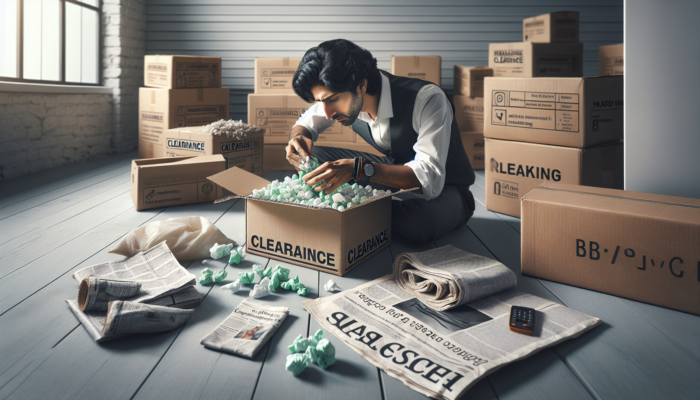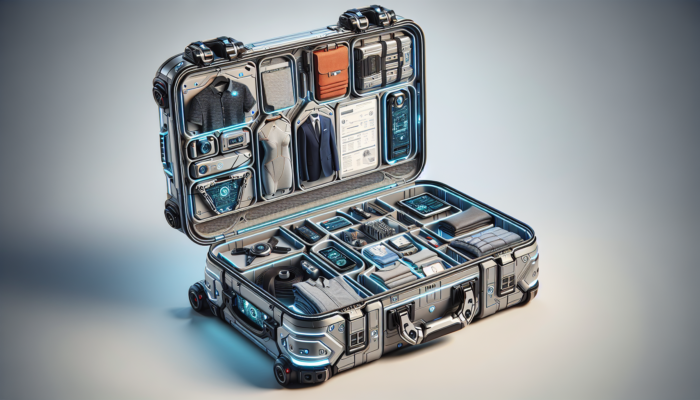Cost-Effective Packing Strategies for Clearance Items: Smart Techniques to Save Money
Stretching Your Budget with Inexpensive and Eco-Friendly Packing Materials

Finding affordable packing materials is crucial for effectively organizing and shipping clearance items while staying within your budget constraints. Recycled cardboard boxes are an excellent option, often sourced from local stores or even repurposed from your home. Their strength makes them ideal for packing a wide array of products, from apparel to electronics. Additionally, newspaper can be crumpled up to provide exceptional cushioning, filling any empty spaces to prevent items from moving around during transit.
This method not only conserves valuable resources but also promotes sustainability. To further enhance your eco-friendly packing efforts, consider using biodegradable packing peanuts, which provide cushioning while being environmentally friendly. Additionally, repurposing old textiles like towels or worn-out clothing can protect fragile items, minimizing reliance on expensive bubble wrap. By adopting these cost-effective packing strategies for clearance items, you can reduce expenses while appealing to an eco-conscious customer base.
Boosting Efficiency and Cutting Costs by Buying Packing Supplies in Bulk
Implementing a bulk purchasing strategy for packing supplies can greatly enhance your efficiency and save money. Handling clearance items often necessitates a consistent supply of packing materials, and by acquiring boxes, tape, and cushioning materials in larger quantities, you can significantly lower your cost per unit. Collaborating with other small businesses for collective purchasing can also enhance your negotiating power and foster community relationships.
Search for wholesalers or online vendors that provide discounts on bulk purchases; some even offer convenient subscription services for packing supplies, ensuring you’re always stocked without the risk of running low. Furthermore, bulk buying can extend to vital shipping necessities like labels and tape, allowing you to maintain an organized supply chain until required. By leveraging the advantages of bulk purchasing, you streamline your packing operations and can dedicate more time to the essential aspects of your business—selling your clearance items.
Creative Do-It-Yourself Packing Solutions for Budget-Friendly Savings
Why not unleash your creativity and discover a variety of innovative and budget-friendly DIY packing solutions? You don’t have to depend solely on store-bought materials. For example, you can craft protective wraps using old blankets or towels, thus eliminating the need for costly bubble wrap. Simply cut them to size and use them to cushion fragile items effectively. Additionally, you can create custom-sized boxes from larger cardboard sheets, ensuring a snug fit that minimizes wasted space. This not only reduces costs but also promotes sustainability by repurposing materials.
Moreover, everyday kitchen items such as egg cartons can provide excellent cushioning for smaller fragile products, while old pool noodles can be sliced to protect the edges and corners of larger items during transport. By utilizing these creative packing ideas for clearance items, you can save money while showcasing your brand’s creativity and dedication to sustainability.
Optimizing Packing Space: Innovative Techniques for Maximum Efficiency

Strategic Layering and Stacking for Optimal Space Utilization During Packing
Maximizing space while packing clearance items is crucial, and one of the most effective techniques is layering and stacking. This method allows you to fully utilize your packing boxes, ensuring every inch is efficiently occupied. Begin by organizing your items according to size and weight, placing heavier items at the bottom for balanced weight distribution. This strategy not only minimizes damage risk but also simplifies handling.
When stacking items, consider using dividers made from cardboard to create individual sections for various items, preventing them from shifting during transport. Layering can also incorporate the strategic use of packing materials; for instance, start with a cushioning layer of crumpled newspaper, place your items, then add another layer for protection. This technique creates a protective barrier around your goods, significantly reducing the risk of damage. By mastering the technique of layering and stacking, you ensure your clearance items arrive safely while also reducing shipping costs.
Maximizing Space with Vacuum Sealing for Soft Goods
Vacuum sealing could be your ultimate approach for efficiently managing clearance items. This method is particularly beneficial for soft goods like clothing and linens, which tend to take up considerable space. By removing excess air, vacuum sealing compresses items, allowing you to fit more into each box. Investing in a vacuum sealer can lead to significant savings in shipping costs, as many shipping companies calculate fees based on size and weight.
Moreover, vacuum sealing protects your items from moisture, dirt, and other environmental factors, ensuring your clearance stock remains in excellent condition upon arrival. For those hesitant to invest in a vacuum sealer, resealable bags offer a budget-friendly alternative; while they may not be as efficient, they still allow for some air removal. By incorporating vacuum sealing into your packing strategies, you maximize space and improve the presentation of your clearance items, making them more enticing to potential customers.
Efficient Nested Packing Techniques for Space Conservation

Utilizing nested packing techniques is another smart method for conserving space and cutting costs when dealing with clearance stock. This strategy involves placing smaller items inside larger ones to optimize space usage. For instance, when packing a set of mugs, consider nesting smaller cups within the larger ones. This technique can also be applied to glassware, where smaller bowls can fit inside larger bowls with cushioning materials in between for added protection.
This approach minimizes the number of boxes required and reduces shipping costs by decreasing overall volume. Additionally, consider nesting boxes themselves; smaller boxes can fit within larger ones, optimizing storage space. The nested packing method can significantly enhance your packing efficiency, allowing you to manage clearance items effectively while ensuring their safety during transit.
Ensuring the Safety of Your Clearance Items: Essential Packing Techniques
Implementing Effective Cushioning Solutions for Maximum Protection
When packing clearance items, ensuring their protection is of utmost importance. This is where efficient cushioning techniques come into play. They not only safeguard your products during transport but also enhance customer satisfaction by ensuring that items arrive in perfect condition. A straightforward method involves using crumpled paper, bubble wrap, or foam peanuts. These materials act as shock absorbers, cushioning items against impacts during transportation.
Always fill any empty spaces within boxes to prevent movement; a well-cushioned package minimizes the risk of damage, significantly reducing the likelihood of costly returns. For especially fragile items, consider double boxing; place the item in a smaller box and cushion it thoroughly before placing that box into a larger one. This additional layer of protection is invaluable, particularly for glass or ceramic items. By employing these cushioning techniques, you prioritize the safety of your clearance items and foster trust with your customers.
Specialized Handling Techniques for Fragile Items to Ensure Their Safety
Packing fragile clearance items demands extra care and attention, as the primary goal is to minimize the risk of damage during transport. The first step involves wrapping each fragile item individually using bubble wrap or thick paper, securing it with tape to prevent unwrapping during transit. Opt for smaller boxes instead of overcrowding larger ones, allowing ample cushioning space. Clearly label these boxes as ‘fragile’ to alert handlers to exercise extra caution.
Moreover, consider using dividers for particularly delicate products, such as glassware or ceramics; these cardboard dividers create individual compartments within a box, preventing items from colliding. By mastering fragile item handling, you not only protect your products but also uphold your brand’s reputation for reliability and care.
Employing Weatherproofing Techniques for Optimal Item Protection
Safeguarding your packed clearance items from environmental factors is crucial, especially when they may be exposed to various climates during shipping. Moisture can seriously damage products, particularly those made from paper or fabric, making weatherproofing solutions a wise investment. Start by utilizing waterproof boxes or bags for items susceptible to moisture exposure.
Additionally, wrapping items in plastic before placing them in boxes can create a protective barrier against rain, humidity, and other environmental threats. If your clearance items include electronics or sensitive products, consider adding silica gel packets to absorb moisture and keep your items dry during transit. By prioritizing weatherproofing solutions, you ensure that your clearance stock remains in outstanding condition, ready to impress your customers upon arrival.
Eco-Friendly Packing Solutions for Clearance Items: Embracing Sustainable Practices
Integrating Sustainable Materials into Your Packing Approach
In today’s environmentally conscious marketplace, utilizing sustainable materials for packing clearance items can help set your business apart from competitors. These materials not only reduce your carbon footprint but also resonate well with eco-aware consumers. Options like recycled paper and cardboard provide protective qualities comparable to new materials while being significantly more sustainable.
Furthermore, biodegradable packing peanuts made from starch or corn serve as an excellent alternative, as they decompose naturally without contributing to landfill waste. Another innovative solution involves using fabric scraps for cushioning; old t-shirts or sheets can be cut into strips to securely wrap items, showcasing both protection and eco-friendliness. By adopting sustainable materials, you not only save costs but also align your business with broader environmental goals, enhancing your brand’s positive image.
Implementing Reusable Packaging Solutions for Long-Term Cost Savings
Adopting reusable packaging solutions represents a brilliant strategy for minimizing waste and achieving long-term cost savings. Instead of relying solely on single-use boxes and bubble wrap, consider materials that can be utilized multiple times. Investing in sturdy, reusable containers made from durable materials can yield significant returns, as they can withstand repeated use without sacrificing quality.
Encourage your customers to return packaging materials for reuse by providing discounts or incentives for returned packaging. This mutually beneficial initiative fosters customer loyalty while reducing waste. By embracing reusable packaging, you not only lower costs but also contribute to a more sustainable economy, appealing to today’s consumers who value environmentally responsible brands.
Exploring Biodegradable Packing Options for a Greener Future
Investigating biodegradable options for packing clearance items is an essential step towards sustainability. These materials naturally decompose, avoiding the long-term landfill impact associated with conventional plastics. Biodegradable packing peanuts, typically derived from natural sources like corn starch, are a guilt-free alternative that dissolve in water. Additionally, consider compostable mailers for shipping; these can break down in composting environments rather than polluting the earth.
Another innovative choice is biodegradable bubble wrap made from plant-based materials. This solution provides essential cushioning for fragile items while remaining environmentally friendly. By incorporating biodegradable options into your packing practices, you enhance your brand’s sustainability profile and cater to a growing market of eco-conscious consumers.
Enhancing Packing Efficiency: Streamlining Your Packing Process
Implementing Time-Saving Techniques for a More Efficient Workflow
Efficiency is vital when packing clearance items, and employing time-saving techniques can dramatically improve your workflow. Start by establishing a clear packing strategy and creating a comprehensive checklist that outlines necessary materials and steps for packing various items. Training your team on these established procedures promotes uniformity and speeds up the process, minimizing the chances of mistakes that could lead to damaged items or incorrect orders.
Additionally, utilizing packing apps or software can streamline operations; these tools can manage inventory, track orders, and automate label printing, allowing you to focus on efficient packing. By prioritizing time-saving techniques, you boost productivity and ensure a smoother operation when handling clearance items.
Designing an Organized Packing Station for Maximum Efficiency
Creating an efficient packing station can transform your packing process from chaotic to streamlined. The secret lies in designing a well-structured, dedicated space that ensures all necessary tools and materials are easily accessible. Consider your workflow; start with packing materials and end with shipping labels. Assign specific areas for tasks such as wrapping, boxing, and sealing to minimize movement and distractions, fostering a more focused packing environment. Incorporating storage solutions like shelving units or bins can further help keep packing materials organized and easy to reach. A well-organized packing station reduces time spent searching for materials and enhances overall efficiency when managing clearance items.
Maximizing Efficiency Through Batch Packing Techniques
Adopting batch packing strategies can significantly enhance your packing efficiency. Instead of packing items one at a time, consider grouping similar items and packing them together. This method leverages repetitive tasks, allowing you to streamline your process. Start by categorizing your clearance items based on size, weight, or type. Once sorted, tackle one category at a time, minimizing the need to switch between different packing methods and helping maintain focus, thereby reducing the risk of errors.
Prepare your packing materials in advance by cutting boxes and labeling items for multiple orders. This proactive approach saves time during the packing phase and keeps your workflow seamless. By implementing batch packing strategies, you enhance efficiency and ensure that your clearance items are dispatched promptly.
Case Studies of Effective Affordable Packing Solutions for Clearance Items
Learning from Successful Retail Examples
To truly understand the effectiveness of affordable packing ideas for clearance items, let’s take a look at real-world examples from retailers that have successfully implemented cost-effective packing solutions. For instance, a prominent clothing retailer transitioned from traditional packaging to recycled cardboard boxes and biodegradable materials for clearance items. This strategic shift not only reduced costs but also appealed to eco-conscious customers, resulting in increased sales. Another retail chain adopted a strategy of reusing shipping boxes received from suppliers. By branding and labeling these boxes, they significantly saved on new packing materials while promoting sustainability. These practical examples demonstrate how innovative thinking can lead to substantial savings and improved brand perception.
Success Stories from Resourceful Small Business Owners
Small businesses often thrive through ingenuity, and many have achieved success using creative packing solutions for their clearance stock. For example, an artisan shop started sourcing materials from local recycling centers, dramatically decreasing their packing costs while supporting the community. This initiative not only cut expenses but also created a compelling brand narrative that resonated with customers.
Another small business launched a ‘bring your own box’ campaign, encouraging customers to use their containers for purchases. This approach minimized packing costs and fostered a sense of community and environmental responsibility. These stories highlight the impact of affordable packing ideas for clearance items, showcasing how they can lead to financial savings and reinforce a strong brand identity.
Insights and Strategies from Online Retailers
Online sellers face unique challenges when packing clearance items, and many have shared valuable insights on managing costs effectively. One successful seller emphasized the importance of sourcing packing materials from local businesses, frequently discovering free boxes and packing supplies through community connections. This strategy not only saved money but also helped build a supportive local network. Another online seller highlighted the effectiveness of using social media to request packing materials.
By posting calls for recycled boxes or packing supplies, they received numerous offers from their community, resulting in significant savings. These insights illustrate that online sellers can successfully implement affordable packing ideas for clearance items by thinking creatively and tapping into community resources, fostering customer loyalty along the way.
Common Questions Addressed About Packing Clearance Items
What Are the Most Affordable Packing Materials Available?
The most budget-friendly packing materials include recycled cardboard boxes, newspapers, and old fabric. These options provide robust protection while remaining economical and environmentally responsible.
How Can I Speed Up the Packing of Clearance Items?
To expedite the packing of clearance items, create a well-organized packing station with all necessary materials easily accessible. Implement batch packing techniques to streamline the process and minimize the time spent on individual orders.
Are Eco-Friendly Packing Options Economically Viable?
Yes, eco-friendly packing options can be economically viable. While initial costs may be slightly higher, utilizing reusable and biodegradable materials can yield long-term savings and attract environmentally conscious customers.
What Is the Best Method for Cushioning Fragile Items?
The optimal method for cushioning fragile items involves wrapping them individually in bubble wrap or thick paper and using packing peanuts or crumpled paper to fill any empty spaces within the box, preventing shifting.
Can Old Clothes Be Used for Packing Purposes?
Absolutely! Old clothes can serve as an excellent alternative to traditional packing materials, providing cushioning and protection for fragile items while keeping expenses low.
How Can I Optimize Space in My Packing Boxes?
Optimize space in your packing boxes by employing layering and stacking techniques; place heavier items at the bottom and fill any gaps with cushioning materials to prevent movement during transit.
What Are Some Creative DIY Packing Ideas?
Creative DIY packing ideas include using egg cartons for small items, fabric scraps for cushioning, and crafting custom-sized boxes from larger cardboard sheets. These solutions are both cost-effective and environmentally friendly.
What Steps Can I Take to Protect My Items from Moisture?
To safeguard items from moisture, use waterproof boxes or bags and incorporate silica gel packets to absorb humidity. Wrapping items in plastic can also create an additional protective barrier against moisture.
What Packing Techniques Are Most Effective for Small Items?
Consider using nested packing techniques for small items, placing them inside larger containers for efficient space utilization. Additionally, using dividers can help organize them and prevent damage.
Is Investing in a Vacuum Sealer Worth It?
Investing in a vacuum sealer can be justifiable if you frequently pack soft items like clothing. It reduces volume, saves on shipping costs, and protects items from moisture and dirt.
Join Our Community on Facebook!
The Article: Affordable Packing Strategies for Clearance Items Was First Found At https://birminghamhouseclearance.com
The Article Packing Strategies for Affordable Clearance Items Was Found On https://limitsofstrategy.com

